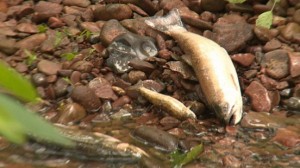31
Jul
Third Time in Three Years – Pesticides Believed to be Cause of Fish Kills in Canada
(Beyond Pesticides, July 31, 2013) Environmental officials are investigating why dozens of dead fish are washing up on the banks of two rivers in western Prince Edward Island (P.E.I.), Canada. For the third time in three years, dead fish have been spotted rising to the surface of Barclay Brook where thousands of fish died in 2011 and 2012 after pesticides from farmers’ fields ran off into the water. 
Almost exactly one year ago, when more than 2,000 dead fish were scooped from the near two-mile stretch of Barclay Brook, dead fish again began washing up on the banks of the same river in western P.E.I. following heavy rains last Friday. About a dozen were found the day of the rains, but officials and volunteers with the local watershed group have since found more than 100. The nearby Mill River also experienced a fish kill, with the first dead fish reported being washed up on Monday. P.E.I. Department of Environment and Environment Canada officials are investigating the fish kills.
Government spokesman Wayne MacKinnon says pesticide run-off could be the cause of the latest fish kill, but water samples collected on the weekend have yet to be tested. Dale Cameron, a member of Trout Unlimited Prince County Chapter, spent three hours pulling more than 20 kilograms of fish ”” mostly trout, but some small salmon ”” out of the Trout River on Monday.
“[The population] can’t stand up to repeated pressure, it’s going to end up ”¦ instead of it recovering in five or six years, if you keep getting it year after year after year then we could be looking at 20 years down the road before it ever gets back to where it was,” he said.
Ecologists believe this fish kill is a huge setback to the recovery of the river, which has been closed to sport fishermen for two years. Typically a river may take five to seven years to recover from a single fish kill incident, however annual kills places additional stress on the system, especially when juvenile fish are lost. In July 2012, about 2,000 dead fish were scooped out of a three-kilometer stretch of Barclay Brook, and a smaller fish kill was reported from the same area in 2011. Environmentalists and sport fishing groups have been complaining about pesticide run off and impacts to fish for years.
“It’s disappointing but quite predictable,” said Peter Bevan-Baker, leader of the provincial Green Party. “With the rain that we’ve had, all of the dots add up and point towards it being a pesticide problem.” Concerned groups believe legislation requiring buffer zones between waterways and farm fields is not working, adding that the real problem is the excessive use of pesticides. The Sierra Club of Canada has said the use of pesticides on the Island should be reduced and that the province should better enforce buffer zone regulations. Whether farmers seriously adhere to buffer requirements to reduce pesticide run-off is in question given the frequency of incidents. In 2011, P.E.I. farmer Avard Robert Smallman was fined $3,000 after he pleaded guilty to farming within 200 meters of a watercourse boundary without the protection of a grass headland. The violation was discovered after Environment Department officers were called in following fish kills in the Trout River, Big Jacques River and Mill River. Environment Canada confirmed that it found traces of a pesticide in bottom sediment in the three rivers.
Agricultural runoff into streams and other aquatic habitat is not a rare occurrence. Runoff impacts aquatic life, especially sensitive and endangered species. In the U.S., sizeable fish kills have resulted from pesticide use, and have often made sensational news headlines, including the 1991 death of over one million fish in Louisiana after aerial spraying of the insecticide azinphos-methyl (Guthion) on sugarcane fields. In 1995, toxic concentrations of endosulfan and methyl parathion along a 16-mile stretch of the Tennessee River in Alabama resulted in 240,000 fish killed. In 2005, an estimated 100,000 to 300,000 black crappie fish died suddenly in Clear Lake in Waseca County, Minnesota. Water samples show the presence of permethrin, the pesticide that had been used two days prior for mosquito control. The pesticide apparently contaminated the lake as run-off from a subsequent rainstorm.
In May 2013, the U.S. Geological Survey (USGS) released a national assessment showing the distribution and trends of pesticide use from 1992-2009, providing visible evidence that contamination of pesticides in waterways is clearly a continuing threat. The spirit of the Clean Water Act is that every community in the United States has the right to enjoy fishable and swimmable bodies of water. These regulations are currently under attack in 2013 Farm Bill language that would strip away critical protections from our nation’s rivers, lakes, and streams. Without the Clean Water Act, there are no common sense backstops requiring applicators to at least consider alternatives to spraying toxic pesticides directly into waterways. Under threat is the National Pollutant Discharge Elimination System (NPDES) permit program for pesticide discharges, administered under the Clean Water Act, that helps monitor pesticides applied near waterways. This helps state authorities and the public know of potential downstream adverse effects, including fish kills and the contamination of drinking waters. Industry has lobbied Congress claiming that the measure to too burdensome to farmers, despite evidence to the contrary.
Congress has currently included language in the 2013 Farm Bill that would eliminate these common sense measures to help protect our nation’s waterways. These highly controversial amendments would undermine the Clean Water Act and put our health and the environment at risk.
Take Action and urge your Congressional Representatives not to undermine The Clean Water Act in the final version of the Farm Bill. Act Now!. Tell your Senators to oppose any efforts to undermine the Clean Water Act.
News Source; Photo Source: CBC News










